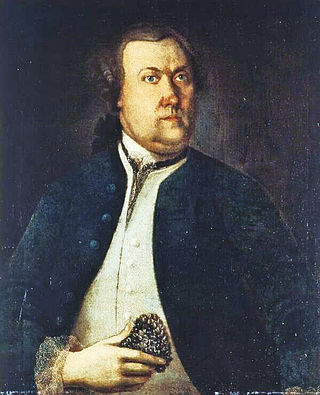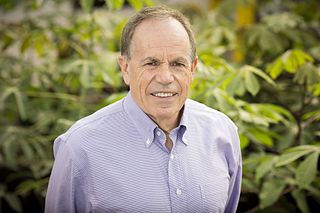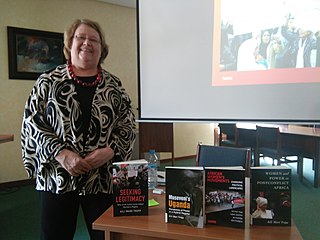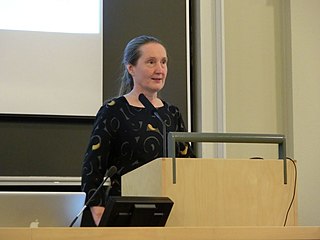Related Research Articles

Pehr Kalm, also known as Peter Kalm, was a Swedish explorer, botanist, naturalist, and agricultural economist. He was one of the most important apostles of Carl Linnaeus.

The Millennium Technology Prize is one of the world's largest technology prizes. It is awarded once every two years by Technology Academy Finland, an independent foundation established by Finnish industries, academic institutions, and the state of Finland. The patron of the prize is the President of Finland. The Millennium Technology Prize is Finland's tribute to innovations for a better life. The aims of the prize are to promote technological research and Finland as a high-tech Nordic welfare state. The prize was inaugurated in 2004.

Photosystem I is one of two photosystems in the photosynthetic light reactions of algae, plants, and cyanobacteria. Photosystem I is an integral membrane protein complex that uses light energy to catalyze the transfer of electrons across the thylakoid membrane from plastocyanin to ferredoxin. Ultimately, the electrons that are transferred by Photosystem I are used to produce the moderate-energy hydrogen carrier NADPH. The photon energy absorbed by Photosystem I also produces a proton-motive force that is used to generate ATP. PSI is composed of more than 110 cofactors, significantly more than Photosystem II.

The Finnish Academy of Science and Letters is a Finnish learned society. It was founded in 1908 and is thus the second oldest academy in Finland. The oldest is the Finnish Society of Sciences and Letters, which was founded in 1838.

Andrew Alm Benson was an American biologist and a professor of biology at the University of California, San Diego, until his retirement in 1989. He is known for his work in understanding the carbon cycle in plants.
The Research Council of Finland is a governmental funding body for scientific research in Finland. Until August 2023, its official English-language name was Academy of Finland. It is based in Helsinki. Yearly, the council administers over 260 million euros to Finnish research activities. Over 5000 researchers are working on projects supported by the council.
The Max Planck Institute of Molecular Plant Physiology is a German research institute for molecular plant physiology, based in the Golm district of Potsdam, Brandenburg. Founded on 1 January 1994, the MPIMP focuses on the study of the dynamics of plant metabolism and how that relates to the entire plant system. The institution is one of the 80 institutes in the Max Planck Society (Max-Planck-Gesellschaft).

Arto Kustaa Salomaa is a Finnish mathematician and computer scientist. His research career, which spans over forty years, is focused on formal languages and automata theory.
Daniel Israel Arnon was a Polish-born American plant physiologist and National Medal of Science recipient whose research led to greater insights into the operation of photosynthesis and nutrition in plants.

Graham Douglas Farquhar, is an Australian biophysicist, Distinguished Professor at Australian National University, and leader of the Farquhar Lab. In 2018 Farquhar was named Senior Australian of the Year.

Govindjee is an Indian-American scientist and educator. He is Professor Emeritus of Biochemistry, Biophysics and Plant Biology at the University of Illinois at Urbana-Champaign, where he taught from 1961 until 1999. As Professor Emeritus since 1999, Govindjee has continued to be active in the field of photosynthesis through teaching and publishing. He is recognized internationally as a leading expert on photosynthesis.

Susanne von Caemmerer is an Australian plant physiologist who is a professor and plant physiologist in the Division of Plant Sciences, Research School of Biology at the Australian National University; and the Deputy Director of the ARC Centre of Excellence for Translational Photosynthesis. She has been a leader in developing and refining biochemical models of photosynthesis.
Guivi A. Sanadze was a Georgian professor, plant physiologist and biochemist. He was a member of Georgian National Academy of Sciences, holder of the Order of Friendship of Peoples and the Order of Honor of Georgia.

Stephen Patrick Long is a British-born American environmental plant physiologist and member of the National Academy of Sciences studying how to improve photosynthesis to increase the yield of food and biofuel crops. He is the Stanley O. Ikenberry Chair Professor of Plant Biology and Crop Sciences at the University of Illinois and visiting professor in Plant Sciences at Lancaster University and at Oxford University, UK. His work, published in Science, proved that photosynthesis can be manipulated to increase plant productivity—an idea once considered the holy grail of plant biology. Long has added to our understanding of the long-term impacts of climate change, such as rising levels of carbon dioxide and ozone on plants. He has briefed former President George W. Bush and the Vatican, as well as Bill Gates and Anne, Princess Royal, on food security and bioenergy.

Aili Mari Tripp is a Finnish and American political scientist, currently the Wangari Maathai Professor of Political Science and Gender and Women's Studies at the University of Wisconsin-Madison.
Muhiba Muhsinovna Yakubova is a Tajikistani biologist.

Anthony William Derek Larkum is a British plant scientist and academic based in Sydney. He is professor emeritus of plant sciences at the University of Sydney and adjunct professor at the University of Technology Sydney (UTS).

Ritva Serimaa was a Finnish physicist and professor, the first female professor of physics at the University of Helsinki. She gained her master's degree in 1982 and defended her doctoral thesis in 1990, becoming a docent of the University of Helsinki in 1992. Her doctoral thesis work and later research concerned X-ray physics and scattering. From 1991 to 1993 she worked at Stanford University making use of their synchrotron light source SSRL. One research focus was the structure of the preserved Swedish warship Vasa, whose structure was at risk due to damage from sulfur-containing compounds. From 2004 she was professor of physics at the University of Helsinki, the first woman to hold such a post.
Mari Johanna Ivaska is a cancer researcher and molecular cell biology academy professor in University of Turku, Finland.
Christina Salmivalli is a Finnish professor of psychology and the deputy head of the INVEST research flagship at the University of Turku in Finland. Salmivalli is recognized as an expert on peer relations and school bullying.
References
- 1 2 "Academician Eva-Mari Aro". 14 March 2017. Retrieved 21 April 2019.
- ↑ Eva-Mari Aro publications indexed by Google Scholar
- 1 2 3 4 Aaltonen, Hannu (1 November 2013). "Eva-Mari Arosta Vuoden Professori". University of Turku, Finland. Retrieved 21 April 2019.
- 1 2 3 "Eva-Mari Aro". University of Turku, Finland. Retrieved 21 April 2019.
- 1 2 3 "Winner of the Finnish Academy of Science and Letters Academy Award for 2018, Academician Eva-Mari Aro". European Academies Science Advisory Council. 26 April 2018. Retrieved 21 April 2019.
- ↑ "Eva-Mari Aro Biography". The Royal Society. Retrieved 21 April 2019.
- ↑ Matikainen, Jussi (18 December 2013). "Professori Eva-Mari Aron ryhmä partneriksi australialaiseen huippuyksikköön". University of Turku, Finland. Retrieved 21 April 2019.
- ↑ "Partners". Plant Energy Biology ARC. Australian Research Council. Retrieved 21 April 2019.
- ↑ "PEB Annual Report". Plant Energy Biology ARC. Australian Research Council. Retrieved 21 April 2019.
- ↑ Sætre, Eivind (16 May 2018). "National and International recognition for NordAqua-leader". NordForsk. Retrieved 21 April 2019.
- ↑ "Towards Versatility of Aquatic Production Platforms: Unlocking the Value of Nordic Bioresources (NordAqua)". NordAqua. Archived from the original on 2018-06-01. Retrieved 21 April 2019.
- ↑ "Eva-Mari Aro Uumajan yliopiston kunniatohtoriksi". University of Turku, Finland. 1 November 2012. Retrieved 21 April 2019.
- ↑ "Eva-Mari Arosta tieteen akateemikko". University of Turku, Finland. 10 March 2017. Retrieved 21 April 2019.
- ↑ "Eva-Mari Aro". National Academy of Sciences. Retrieved 21 April 2019.
- ↑ "Eva-Mari Aro". Member. Academia Europaea. Retrieved 2025-01-02.